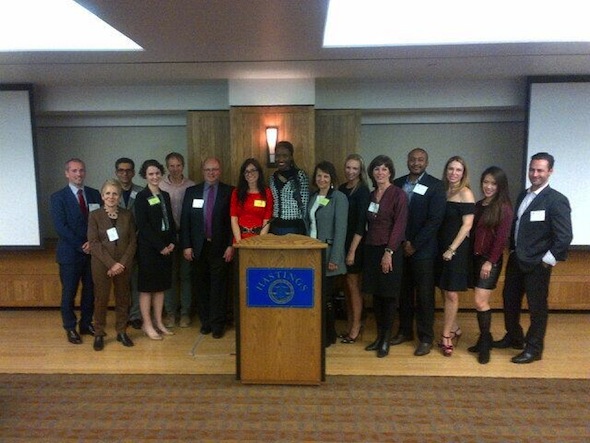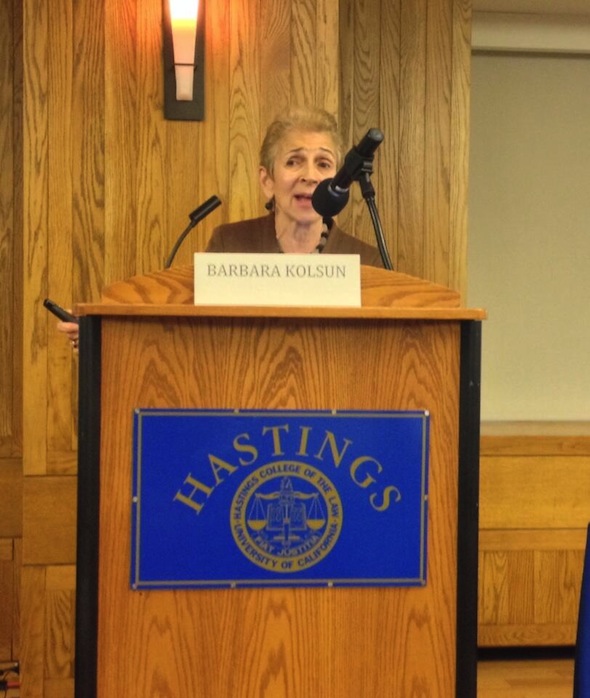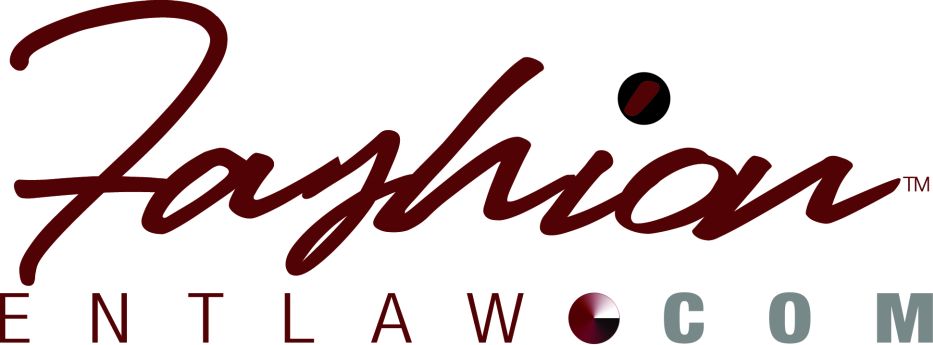SAN FRANCISO, CA – “What a sight to behold,” was what I thought when I walked into the swanky room that was non-existent when I attended U.C. Hastings College of the Law in the late 90s to early 2000. The room was located on the first floor of the 200 McAllister building, Hastings’ address.
It was lunchtime and before me was a room full of stylishly dressed men and women in designs that encompassed the fall and spring colors. They were eating lunch while actively interacting and networking with each other. Lunch, which I also had the opportunity to taste, was free and delicious and provided courtesy of the Hastings Fashion, Art & Design Law Society (FLS), the producers of the first ever west coast Fashion Law Symposium (titled ‘Growth in the Fashion Industry: A New Approach to Protection?).
The men and women in the room were guests, speakers and Hastings law students who had gathered for the inaugural symposium. It was a beautiful and delicious sight to behold and a foretaste of the equally delicious, colorful and stimulating intellectual discussions on fashion law to come.
Due to prior work obligations, I missed the morning sessions of the symposium specifically: Ashli Weiss’ (founder and president of the FLS) welcome address, and Keanan Duffty, Barbara Kolsun and Susan Scafidi’s keynote addresses. I also missed the panel on ‘Counterfeit on the Web.’ Nevertheless, I was quickly brought up to speed by some of the guest attendees; and of course social media, were some of the highlights of the speech was shared by some of the guests and speakers attending the event.
THE BRILLIANT SPEAKERS
 In the opening key note, ‘State of the Fashion Industry’ for the morning, delivered by Keanan Duffty, a British Fashion Designer, Musician, Author and Senior Director of Merchandising at the Academy of Art University School of Fashion, he addressed the legal needs of young fashion designers in the areas of trademarks, brand licensing and design patents.
In the opening key note, ‘State of the Fashion Industry’ for the morning, delivered by Keanan Duffty, a British Fashion Designer, Musician, Author and Senior Director of Merchandising at the Academy of Art University School of Fashion, he addressed the legal needs of young fashion designers in the areas of trademarks, brand licensing and design patents.
For almost a decade now, I have been covering, in a journalistic capacity, shows and prominent fashion personalities at the Academy of Arts’ events both in San Francisco and at New York Fashion Week. My last coverage for an event in San Francisco was last year when Suzy Menkes visited the school and Max and Lubov Azria were honored (watch here). At that event, I specifically discussed Fashion Law while chatting with the school’s President. It was the second time I was doing so and she remained very interested and receptive to hearing more about it. So, I was particularly pleased to hear and see that the school had a representative at the inaugural Hastings fashion law symposium.
Following Keanan’s keynote, Barbara Kolsun an author, Adjunct Professor of Law and General Counsel for Stuart Weiztman gave her keynote addressing the ‘State of Fashion Law.’ Kolsun, a former actress and singer turned fashion lawyer with an impressive career and work with some of the biggest fashion brands, discussed how she became a fashion lawyer and also discussed the kinds of issues fashion lawyers are confronted with including trademarks, counterfeits and licensing. The fashion law veteran who started the fashion law department for Stuart Weiztman, by all accounts, was witty, funny and provided valuable insight on the topics she addressed.
Finally, the beautiful Susan Scafidi spoke about some of the latest and hottest issues in fashion law, as part of her ‘State of Fashion Law’ address; including unpaid interns, and race discrimination.
Of course, a keynote from Susan would be incomplete without the discussion of the Innovative Design Piracy Act (IDPA), a bill she helped spearhead in congress but which was unsuccessful. The goal of IDPA is simple. Fashion design enjoys no protection under copyright law, except under very limited cases. What Susan wants to do is have congress amend Title 17 of the United States Code to provide a “sui generis” protection to fashion designers. The act would extend protection to the overall appearance of an article of apparel including its ornamentation. The protection would be for three years and designers would be required to register with the US copyright office within three months of going public with their designs to receive protection. Susan believes majority of the fashion industry supports the IDPA but the “pirates and lawyers who represent” them are opposed to it. Nevertheless, Susan remains optimistic that US fashion designers will receive design protection in the future.
Finally, the panel I missed on ‘Counterfeit on the Web’ was comprised of Lawrence Siskind, Thomas Onda and Paolo Beconcini. This panel, by all accounts, was also a very insightful one. They discussed the increase in counterfeit goods on the web, which is further exarcebated by the internet (including new media and social media). They also discussed the need for brand owners to take an active role in protecting their brand value and fighting counterfeiters. Paolo Beconcini, a US attorney with a focus on Intellectual Property in China, shared China’s effort in combatting counterfeit by passing a recent law that would seize and destroy tools used to produce counterfeit goods.
For my panel, which began after lunch, I spoke on ‘Social Media, Fair Use & The Fashion Industry.” The ‘Social Media and Fair Use’ panel was made up of three Hastings Alumni (go Hastings ☺) Uduak Oduok (EBITU LAW GROUP, P.C.), Ali Marquart (Marquart & Small, LLP), and Karen Frank (Coblentz, Patch, Duffy and Bass, LLP), Laurie Mueller (Product Manager at Facebook) Brad Carrick (Harvard Alum/Lord & Betram, P.C.) & Gregory Lemmons (Santa Clara Alum/Lord & Betram, P.C.).
Brad and Greg opened the panel with discussions using the Pinterest story of an attorney and photographer who became concerned that her use of Pinterest was an infringement on the work of other copyright holders. Accordingly, she embarked on legal research and analysis to alleviate her concern. Brad and Greg did not provide the conclusion to the story. Instead, they transitioned to the introduction of the speakers teasing the audience with a conclusion at the end of our presentations.
I was the first up and focused my presentation on three key points which was that that: a) social media had disrupted the fashion and legal industries; b) fashion lawyers must understand this disruption; and c) fashion lawyers must be prepared to meet this disruption with innovative lawyering. I also laid the legal framework for an analysis on fair use and the four factors associated with a fair use defense under copyright law. Where I left off, Karen Frank explored and discussed the case laws governing fair use and what the courts have deemed to be fair use and non-fair use both within the copyright and trademark law context. Karen wrapped up her presentation by also discussing the implications for advertisers adopting social media for their businesses. Finally, for the ‘Social Media & Fair Use Panel, ‘ Ali Marquart discussed the ‘Right of Publicity’.
Ali explained what ‘Right of Publicity’ was and briefly contrasted New York and California laws on right of publicity as well as discussed practices in other jurisdictions including Indiana. She then provided examples of ‘Right of Publicity’ cases on the internet; and the tension with fair use and right of publicity, issues the industry confronts daily and will continue to.
Finally, rounding off the presentation was Laurie Mueller who discussed Facebook’s products and explained how she was amazed at the other side of fashion as she listened to all the lawyers in the room i.e. the legal side of fashion she never contemplated.
Laurie along with Brad also shared stories of having their identity stolen on Facebook and referenced Marquart’s discussion on the ‘Right of Publicity.’
That was the end of our presentation. We filtered questions from the audience during our presentation so Brad & Greg returned, at the end, to their Pinterest story to wrap things up. They told us the lawyer decided to forego using Pinterest but her post generated numerous comments and discussion on fair use. They also reiterated there was no answer to an ever evolving question in the digital age on what is and what isn’t fair use. The answer was really the tried and tested response from lawyers, “it depends.” 🙂
The session ended and Ashli Weiss and her team announced it was time for a break.
A little after 3:00pm, all reconvened for the final key note for the evening delivered by Staci Riordan, Partner & Chair of The Fashion law Group at Fox Rothschild, LLP and Founder of Loyola’s Fashion Law Project, the first fashion law school on the West Coast.
Staci shared her experience and journey into fashion law and emphasized an underlying theme of having the drive, passion, focus and discipline to go after what you want, put in the work and think outside the box.
My favorite part of her speech was two fold: 1) she encouraged young lawyers to become indispensable and 2) she also encouraged them to discover their niche and build on it. In terms of the future trends for fashion and fashion lawyers, she believed it would include real estate/leasing transactions and mergers and acquisitions. For those without any industry background, she encouraged them to read industry trade publications including Women’s Wear Daily, among others, to stay on the pulse of issues affecting the industry.
After Riordan, and after a short break, it was time for the final panel for the evening, the ‘Design Patents in Apparel‘ panel. The panel consisted of the brilliant Mark Lemley (Director of Stanford University’s Law, Science & Technology), the equally brilliant and beautiful Sarah Burstein (Associate Professor of Law at the University of Oklahoma) and Dana Beldiman (Partner at Carroll, Burdick & McDonough, LLP and Professor at UC Hastings).
Now typically, when you talk Patent law/design, many, myself included, can only take so much and then it is time for a break. It is typically seen as an area for the hard sciences and not as sexy as trademark or copyright law. However, this panel succeeded in keeping it very simple and easy to understand to an attentive audience that were eager to absorb it all. Moderated by attorney Babak Kusha (Partner at Kilpatrick Townsend, LLP, who by the way donated a really cool min-ipad for the raffle at the reception), the panel focused on the under utilization of design patents in the fashion industry and did a great job of using comparisons with trademark and copyright law to drive home their points.
Dana also focused on practices on the international front especially in Europe. She also shared some best practices tips to protect design patents in Europe. Sarah brought up an interesting point that hard science backgrounds are typically needed to practice patent law, yet there was a need for attorneys with fashion/apparel industry experience in assisting fashion clients with design patent issues.
Mark also brought up an interesting point on the difference in damages when it comes to trademark, copyright and patent law. Specifically as to design patent infringement, he used an analogy demonstrating with his IPhone that if a company where to infringe on Apple’s music design icon, for example, the company, if found liable, would be required to also pay the total net profits from the sale of the article ( the phone) containing the infringing design, rather than just the infringing design.
Finally, the panel also discussed 3D printing. Mark said he foresaw a lot of litigation around 3D printing as its popularity increases and users begin to download/print 3D physical objects. He also pointed out that Internet Service Providers were not necessarily shielded from liability when it came to design patents, unlike the Digital Millennium Copyright Act ’s (DMCA) safe harbor for ISP providers in copyright infringement cases.
I indeed found the panel discussions to be quite interesting.
The session ended and Dana, who was also an advisor to Hastings FLS society in organizing this event, gave the closing remarks. She said the goal was simple in planning this inaugural fashion law symposium. They wanted to put UC Hastings on the “Fashion Law map.” She concluded that the mission was accomplished, to which the audience in the room responded with hearty applauses and cheers. She then adjourned the event and Ashli Weiss invited guests to join the organization for a reception at the school’s Sky lounge room, which included the raffle of a very cool designer bag donated by Barbara Kolsun, the mini-ipad by Babak Kusha, a mentor-mentee time and an opportunity to attend a New York Fashion Week show by yours truly, a mentor-mentee time and hangout with Brad and Greg, and also a donation from Keanan Duffty, among others.
THE HIGHLY CURIOUS GUESTS

Let me say some few words about the guests and the students who put this event together before wrapping it all up!
In addition to the remarkable speakers across the country who brought the positive and amazing energy to the Fashion Law Symposium, not to be ignored were the guests. I was thoroughly impressed by the guests present. There was an attorney who came from the UK, another from China, one from Mexico and one from Brazil. Wow!
Equally impressive was the first year student Peggy, from De Paul University in Chicago, who flew in just for the conference. I was also quite impressed by the number of guests from Los Angeles who flew down for the event including Leneer from Whittier Law School. Indeed highly impressive and to me speaks to the hunger for fashion law that is yet to be filled and needs to.
Local law schools and attorneys were also present. I had the privilege of meeting two students from Stanford Law who came to the Hastings Symposium in hopes that they could replicate the same thing at Stanford. I also met two Golden Gate University School of Law students who also came with the same intentions.
It was also hard to miss the lovely Tanya Falleiro who I met for the first time, a practicing attorney who tweeted about the event and also is looking to bring fashion law to the San Francisco Bar Association.
Really, there is no way to put it than the observation from a UC Hastings student who I had the privilege of meeting. He summed it up best. He said he had recently attended an Intellectual Property event and it was nothing compared to the depth, and insight that he saw displayed at the first ever west coast Fashion Law Symposium produced by UC Hastings College. Indeed. As one who has produced events as well as attended numerous ones locally, nationally and internationally, this was a job very well done.
THE HASTINGS LAW STUDENTS WHO MADE IT HAPPEN

My narration of my experience at the inaugural fashion law symposium would be incomplete without the acknowledgement of the Hastings law students who made it all happen. These students were active and began planning almost six months prior to the event. They employed social media, Hastings alumni and the fashion law community to help plan and spread the word. They also engaged the help of local organizations like California Lawyers for the Arts, the Academy of Art University and more to again help spread the word. They were organized in their presentation and professionalism and they executed excellently well and above par, especially from what one would expect from law students; and indeed staged a very professional and extremely successful event they should all be very proud of. I am indeed proud to say I am a Hastings alum and to know that the future of the fashion law profession and the legal industry, at large, lies in the hands of these dynamic, driven and energetic future young lawyers.
So, a special shout out to: Ashley Bumatay, Danielle Chang, Sophia Cizmarik, Mohneet Dhaliwal, Afshin Emrani, Ariana Goodell, Makala Keys, Irina Lyapis, Nirali Patel, Lilit Hayrapeti and most especially the leader of the pack Ashli Weiss (my mentee and I like to say my protégé ☺) whose vision and determination has launched what I know will be a long lasting legacy of a formidable fashion law program at Hastings. Thank you to all of you.
Thank you to my fashion law colleagues as well for letting me experience and be a part of history with you all.
Official photos and video clips coming soon once Hastings publishes it.
In the meantime, enjoy the arguably fair use photos ripped off from Lilit Hayrapeti, Staci Riordan and Fashion Blawger’s twitter handles. ☺
Cheers,
Uduak

FASHIONENTLAW blog, authored by Ms. Uduak, was first established in 2010. It is now incorporated, in 2021, as part of the FASHIONENTLAW LAW FIRM blog. The blog is for informational purposes only and provides legal commentary and analysis on the intersection of mainstream America pop culture and the law. It also provides updates on Ms. Uduak’s speaking engagements and press activities. For inquiries on topics covered on this site, please get in touch with our firm. If you seek legal representation for your specific legal needs, please schedule a consultation.
📞Call 916-857-9970 or
🌐Email (firm@fashionentlaw.con)
💻 Schedule a consultation directly on this site.
